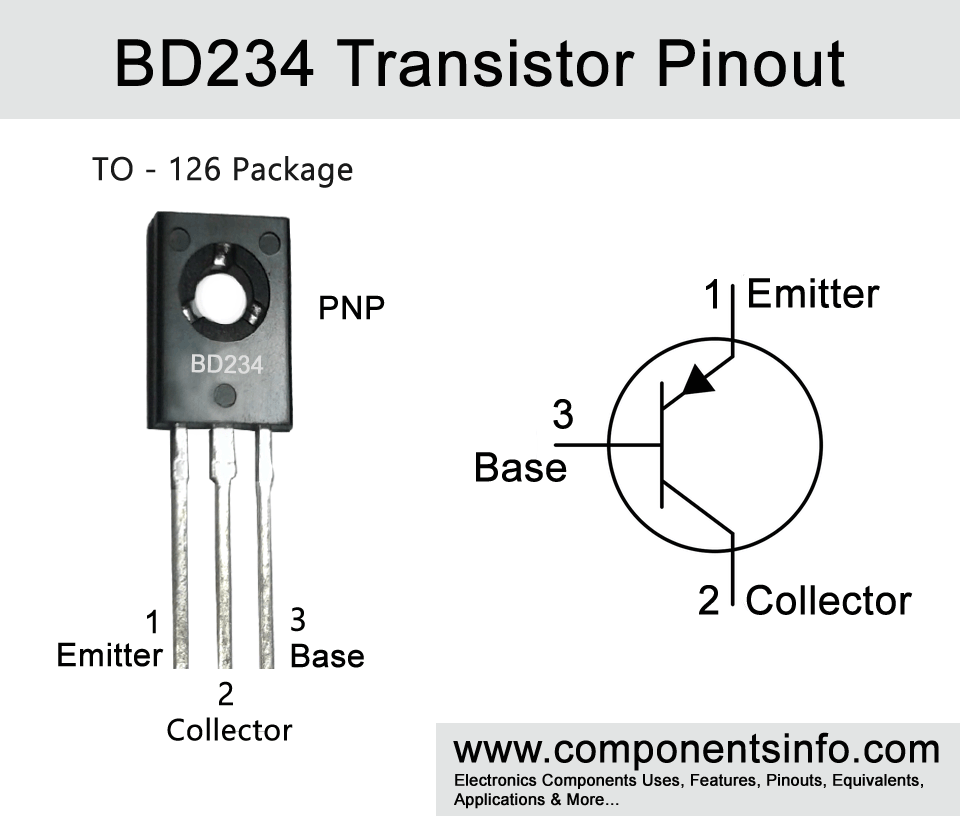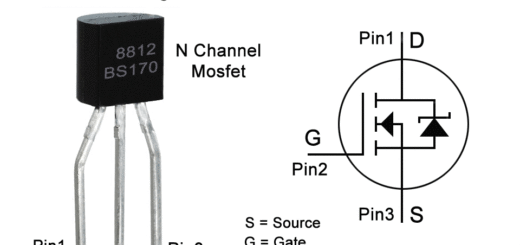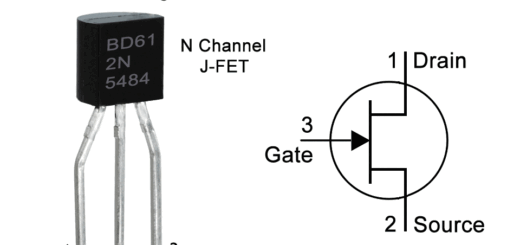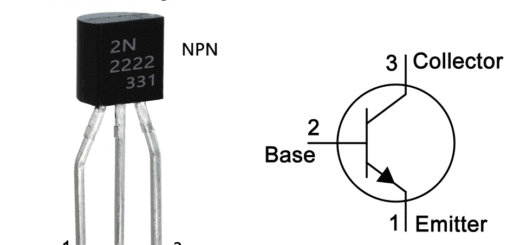BD234 Transistor Pinout, Equivalents, Features, Applications and More
BD234 is another transistor from the BD23X series of medium power PNP transistors. In this post we are going to discuss BD234 transistor pinout, equivalents, features, applications, and other useful info about this transistor.
Absolute Maximum Ratings:
- Package Type: TO-126
- Transistor Type: PNP
- Max Collector Current(IC): -2A
- Max Collector-Emitter Voltage (VCEO): -45V
- Max Collector-Base Voltage (VCBO): -45V
- Max Emitter-Base Voltage (VEBO): -5V
- Max Collector Power Dissipation (Pc): 25 Watt
- Minimum DC Current Gain (hFE): 40
- Transition Frequency is: 3MHz
- Max Storage & Operating temperature: -65 to +150 Centigrade
NPN Complementary:
NPN Complementary of BD234 is BD233
Replacement and Equivalent:
BD726, BD722, BD684, BD440, BD380, BD378, BD376, BD336, BD332, BD294, BD288, BD238, BD236, BD234, 2SB996, 2SB993, 2SB966, 2SB577, 2SB574, 2SB1429, 2SB1355, 2SB1347, 2SB1159, 2SB1157, 2SB1155, 2SA769.
BD234 Transistor Explained / Description:
BD234 is another transistor from BD23x series of medium power transistors designed to use in switching and amplification applications. The transistor is available in TO-126 package. The pin layout of the transistor is as follows: the first pin is Emitter, second is Collector and the third is Base.
The absolute maximum ratings of the transistor are: its collector-base voltage (VCBO) is -45V, collector-emitter voltage (VCEO) is also -45V, collector current is -2A, emitter-base voltage is -5V and collector dissipation is 25W.
As mentioned above BD234 is a transistor of BD23x series which also contains other transistors such as BD236 and BD238. The major difference among these transistors are their voltage rantings such as their VCBO, VCEO VCER, VCEO(sus), and ICBO ratings. But you can easily replace the BD234 with BD236 and BD238 in almost any application because BD234 has minimum voltage ratings and the other two have higher voltage ratings. However, we cannot use BD234 as an alternative to BD236 and BD238 in applications that require to drive the load of more than -45V.
Where We Can Use it & How to Use:
BD234 is specially designed to use in switching and amplification applications but it is not limited only to these applications but can be used variety of other applications. The detailed list of its applications can be found under the applications heading below.
Now to use the transistor in whatever applications first you have to understand its pin layout and then decide how you are going to use it. To use as a switch connect its Emitter pin with the positive supply of the circuit, connect its base pin with the signal output from which you want to control the load and connect collector with the positive side of the load and the negative side of the load will be connected with the negative rail.
When it comes to use the transistor as an amplifier it is important to note that there are many types of amplifiers so it depends on your requirements which type of amplifier you want to make. In this example, we are providing the procedure of a simple transistor amplifier circuit. First, connect emitter pin of the transistor with the positive supply, then connect the base of the transistor with the signal you want to amplify and connect the collector of the transistor to a sound producing device i.e speaker and the other wire of the speaker will be connected with the negative rail of the circuit. But you also have to use some filter capacitor between the connection of the transistor with other components.
Applications:
Power Supplies
Switching Circuits
Motor Control
Audio Amplifiers
Voltage inverters
LED Drivers
DC to DC Converters
Battery Operated Applications
Pulse Generator
Voltage Regulation
Safe Operating Guidelines:
Here are the safe operating guidelines for the transistor.
- First of all as we always suggest do not use the transistor to its absolute maxim and always stay at least 20% below from its max ratings.
- The maximum load the transistor is capable to drive is -2A but as 20% rule we will not drive load of more than 1.6A.
- The max load voltage is -45V so we will not drive a load of more than 36V.
- The temperature of the transistor should also be maintained between -65°C and 150°C.
Datasheet:
To download the datasheet just copy and paste the below link in your browser.
https://datasheetspdf.com/pdf-down/B/D/2/BD234_FairchildSemiconductor.pdf



